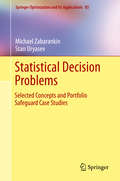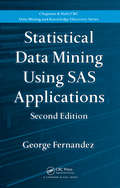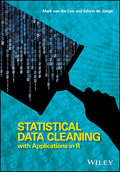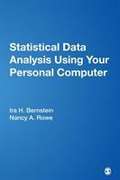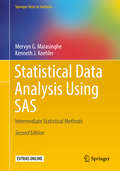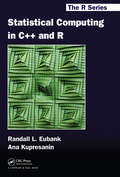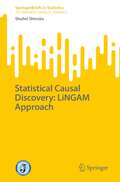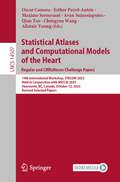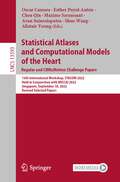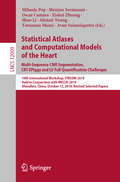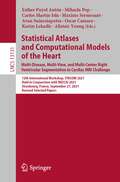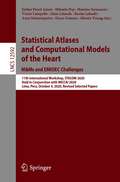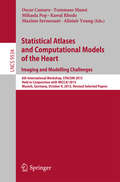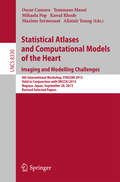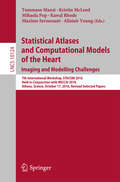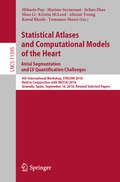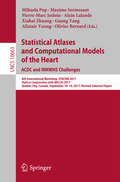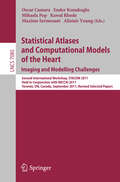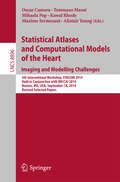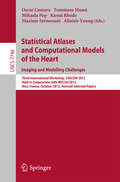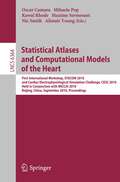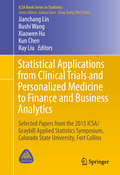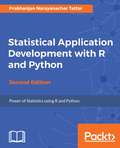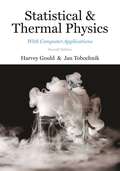- Table View
- List View
Statistical Decision Problems: Selected Concepts and Portfolio Safeguard Case Studies (Springer Optimization and Its Applications #85)
by Michael Zabarankin Stan UryasevStatistical Decision Problems presents a quick and concise introduction into the theory of risk, deviation and error measures that play a key role in statistical decision problems. It introduces state-of-the-art practical decision making through twenty-one case studies from real-life applications. The case studies cover a broad area of topics and the authors include links with source code and data, a very helpful tool for the reader. In its core, the text demonstrates how to use different factors to formulate statistical decision problems arising in various risk management applications, such as optimal hedging, portfolio optimization, cash flow matching, classification, and more. The presentation is organized into three parts: selected concepts of statistical decision theory, statistical decision problems, and case studies with portfolio safeguard. The text is primarily aimed at practitioners in the areas of risk management, decision making, and statistics. However, the inclusion of a fair bit of mathematical rigor renders this monograph an excellent introduction to the theory of general error, deviation, and risk measures for graduate students. It can be used as supplementary reading for graduate courses including statistical analysis, data mining, stochastic programming, financial engineering, to name a few. The high level of detail may serve useful to applied mathematicians, engineers, and statisticians interested in modeling and managing risk in various applications.
Statistical Data Mining Using SAS Applications
by George FernandezStatistical Data Mining Using SAS Applications, Second Edition describes statistical data mining concepts and demonstrates the features of user-friendly data mining SAS tools. Integrating the statistical and graphical analysis tools available in SAS systems, the book provides complete statistical data mining solutions without writing SAS program co
Statistical Data Cleaning with Applications in R
by Mark van der Loo Edwin de JongeA comprehensive guide to automated statistical data cleaning The production of clean data is a complex and time-consuming process that requires both technical know-how and statistical expertise. Statistical Data Cleaning brings together a wide range of techniques for cleaning textual, numeric or categorical data. This book examines technical data cleaning methods relating to data representation and data structure. A prominent role is given to statistical data validation, data cleaning based on predefined restrictions, and data cleaning strategy. Key features: Focuses on the automation of data cleaning methods, including both theory and applications written in R. Enables the reader to design data cleaning processes for either one-off analytical purposes or for setting up production systems that clean data on a regular basis. Explores statistical techniques for solving issues such as incompleteness, contradictions and outliers, integration of data cleaning components and quality monitoring. Supported by an accompanying website featuring data and R code. This book enables data scientists and statistical analysts working with data to deepen their understanding of data cleaning as well as to upgrade their practical data cleaning skills. It can also be used as material for a course in data cleaning and analyses.
Statistical Data Cleaning with Applications in R
by Mark van der Loo Edwin de JongeA comprehensive guide to automated statistical data cleaning The production of clean data is a complex and time-consuming process that requires both technical know-how and statistical expertise. Statistical Data Cleaning brings together a wide range of techniques for cleaning textual, numeric or categorical data. This book examines technical data cleaning methods relating to data representation and data structure. A prominent role is given to statistical data validation, data cleaning based on predefined restrictions, and data cleaning strategy. Key features: Focuses on the automation of data cleaning methods, including both theory and applications written in R. Enables the reader to design data cleaning processes for either one-off analytical purposes or for setting up production systems that clean data on a regular basis. Explores statistical techniques for solving issues such as incompleteness, contradictions and outliers, integration of data cleaning components and quality monitoring. Supported by an accompanying website featuring data and R code. This book enables data scientists and statistical analysts working with data to deepen their understanding of data cleaning as well as to upgrade their practical data cleaning skills. It can also be used as material for a course in data cleaning and analyses.
Statistical Data Analysis Using Your Personal Computer (PDF)
by Ira H. Bernstein Nancy A. RoweWhat should you see when you are analyzing real data using one of the major statistical packages, such as SPSS, SAS or Microsoft Excel? This book will show you, and will walk you through the output from a variety of statistical outcomes, such as data reflecting a single common factor. Through the use of actual demonstrations, the authors supply readers with the computer programs necessary to simulate data sets with the statistical properties (usually multivariate) that are often assumed of real data. The reader is then shown how to analyze these data sets and how to interpret the results. The book begins with a general introduction to doing research and tips for using the three statistical packages. The authors next explore how to create data structures and perform univariate, bivariate, and multivariate simulations. They then show how to use the simulations to understand common statistical algorithms and their outputs when doing a basic correlation analysis, exploratory factor analysis, confirmatory factor analysis, multidimensional scaling, multiple regression, discriminate analysis, classification analysis and MANOVA. Throughout the book, the authors provide the reader with helpful guides, such as: ·Hint boxes to give readers tips for executing particular techniques using the statistical software packages. ·Steps that show each stage of a procedure, such as importing an Excel file into SAS. ·Problems end each chapter so the reader can practice the techniques described. ·Web Site with the SAS and SPSS programs and sample data.
Statistical Data Analysis Using SAS: Intermediate Statistical Methods (Springer Texts in Statistics)
by Mervyn G. Marasinghe Kenneth J. KoehlerThe aim of this textbook (previously titled SAS for Data Analytics) is to teach the use of SAS for statistical analysis of data for advanced undergraduate and graduate students in statistics, data science, and disciplines involving analyzing data.The book begins with an introduction beyond the basics of SAS, illustrated with non-trivial, real-world, worked examples. It proceeds to SAS programming and applications, SAS graphics, statistical analysis of regression models, analysis of variance models, analysis of variance with random and mixed effects models, and then takes the discussion beyond regression and analysis of variance to conclude.Pedagogically, the authors introduce theory and methodological basis topic by topic, present a problem as an application, followed by a SAS analysis of the data provided and a discussion of results. The text focuses on applied statistical problems and methods. Key features include: end of chapter exercises, downloadable SAS code and data sets, and advanced material suitable for a second course in applied statistics with every method explained using SAS analysis to illustrate a real-world problem.New to this edition:• Covers SAS v9.2 and incorporates new commands• Uses SAS ODS (output delivery system) for reproduction of tables and graphics output• Presents new commands needed to produce ODS output• All chapters rewritten for clarity• New and updated examples throughout• All SAS outputs are new and updated, including graphics• More exercises and problems• Completely new chapter on analysis of nonlinear and generalized linear models• Completely new appendixMervyn G. Marasinghe, PhD, is Associate Professor Emeritus of Statistics at Iowa State University, where he has taught courses in statistical methods and statistical computing.Kenneth J. Koehler, PhD, is University Professor of Statistics at Iowa State University, where he teaches courses in statistical methodology at both graduate and undergraduate levels and primarily uses SAS to supplement his teaching.
Statistical Computing in C++ and R (Chapman And Hall/crc The R Ser.)
by Randall L. EubankWith the advancement of statistical methodology inextricably linked to the use of computers, new methodological ideas must be translated into usable code and then numerically evaluated relative to competing procedures. In response to this, Statistical Computing in C++ and R concentrates on the writing of code rather than the development and study o
Statistical Causal Discovery: LiNGAM Approach (SpringerBriefs in Statistics)
by Shohei ShimizuThis is the first book to provide a comprehensive introduction to a new semiparametric causal discovery approach known as LiNGAM, with the fundamental background needed to understand it. It offers a general overview of the basics of the LiNGAM approach for causal discovery, estimation principles, and algorithms. This semiparametric approach is one of the most exciting new topics in the field of causal discovery. The new framework assumes parametric assumptions on the functional forms of structural equations but makes no assumption on the distributions of exogenous variables other than non-Gaussianity. It provides data-analysis tools capable of estimating a much wider class of causal relations even in the presence of hidden common causes. This feature is in contrast to conventional nonparametric approaches based on conditional independence of variables. This book is highly recommended to readers who seek an in-depth and up-to-date overview of this new causal discovery approach to advance the technique as well as to those who are interested in applying this approach to real-world problems. This LiNGAM approach should become a standard item in the toolbox of statisticians, machine learners, and practitioners who need to perform observational studies.
Statistical Atlases and Computational Models of the Heart. Regular and CMRxRecon Challenge Papers: 14th International Workshop, STACOM 2023, Held in Conjunction with MICCAI 2023, Vancouver, BC, Canada, October 12, 2023, Revised Selected Papers (Lecture Notes in Computer Science #14507)
by Oscar Camara Esther Puyol-Antón Maxime Sermesant Avan Suinesiaputra Qian Tao Chengyan Wang Alistair YoungThis book constitutes the proceedings of the 14th International Workshop on Statistical Atlases and Computational Models of the Heart, STACOM 2023, as well as the Cardiac MRI Reconstruction Challenge, CMRxRecon Challenge. There was a total of 53 submissions to the workshop. The 24 regular workshop papers included in this volume were carefully reviewed and selected from 29 paper submissions. They deal with cardiac segmentation, modelling, strain quantification, registration, statistical shape analysis, and quality control. In addition, 21 papers from the CMRxRecon challenge are included in this volume. They focus on fast CMR image reconstruction and provide a benchmark dataset that enables the broader research community to promote advances in this area of research.
Statistical Atlases and Computational Models of the Heart. Regular and CMRxMotion Challenge Papers: 13th International Workshop, STACOM 2022, Held in Conjunction with MICCAI 2022, Singapore, September 18, 2022, Revised Selected Papers (Lecture Notes in Computer Science #13593)
by Oscar Camara Esther Puyol-Antón Chen Qin Maxime Sermesant Avan Suinesiaputra Shuo Wang Alistair YoungThis book constitutes the proceedings of the 13th International Workshop on Statistical Atlases and Computational Models of the Heart, STACOM 2022, held in conjunction with the 25th MICCAI conference. The 34 regular workshop papers included in this volume were carefully reviewed and selected after being revised and deal with topics such as: common cardiac segmentation and modelling problems to more advanced generative modelling for ageing hearts, learning cardiac motion using biomechanical networks, physics-informed neural networks for left atrial appendage occlusion, biventricular mechanics for Tetralogy of Fallot, ventricular arrhythmia prediction by using graph convolutional network, and deeper analysis of racial and sex biases from machine learning-based cardiac segmentation. In addition, 14 papers from the CMRxMotion challenge are included in the proceedings which aim to assess the effects of respiratory motion on cardiac MRI (CMR) imaging quality and examine the robustness of segmentation models in face of respiratory motion artefacts. A total of 48 submissions to the workshop was received.
Statistical Atlases and Computational Models of the Heart. Multi-Sequence CMR Segmentation, CRT-EPiggy and LV Full Quantification Challenges: 10th International Workshop, STACOM 2019, Held in Conjunction with MICCAI 2019, Shenzhen, China, October 13, 2019, Revised Selected Papers (Lecture Notes in Computer Science #12009)
by Mihaela Pop Maxime Sermesant Oscar Camara Xiahai Zhuang Shuo Li Alistair Young Tommaso Mansi Avan SuinesiaputraThis book constitutes the thoroughly refereed post-workshop proceedings of the 10th International Workshop on Statistical Atlases and Computational Models of the Heart: Atrial Segmentation and LV Quantification Challenges, STACOM 2019, held in conjunction with MICCAI 2019, in Shenzhen, China, in October 2019. The 42 revised full workshop papers were carefully reviewed and selected from 76 submissions. The topics of the workshop included: cardiac imaging and image processing, machine learning applied to cardiac imaging and image analysis, atlas construction, statistical modelling of cardiac function across different patient populations, cardiac computational physiology, model customization, atlas based functional analysis, ontological schemata for data and results, integrated functional and structural analyses, as well as the pre-clinical and clinical applicability of these methods.
Statistical Atlases and Computational Models of the Heart. Multi-Disease, Multi-View, and Multi-Center Right Ventricular Segmentation in Cardiac MRI Challenge: 12th International Workshop, STACOM 2021, Held in Conjunction with MICCAI 2021, Strasbourg, France, September 27, 2021, Revised Selected Papers (Lecture Notes in Computer Science #13131)
by Oscar Camara Mihaela Pop Maxime Sermesant Alistair Young Avan Suinesiaputra Karim Lekadir Esther Puyol Antón Carlos Martín-IslaThis book constitutes the proceedings of the 12th International Workshop on Statistical Atlases and Computational Models of the Heart, STACOM 2021, as well as the M&Ms-2 Challenge: Multi-Disease, Multi-View and Multi-Center Right Ventricular Segmentation in Cardiac MRI Challenge.The 25 regular workshop papers included in this volume were carefully reviewed and selected after being revised. They deal with cardiac imaging and image processing, machine learning applied to cardiac imaging and image analysis, atlas construction, artificial intelligence, statistical modelling of cardiac function across different patient populations, cardiac computational physiology, model customization, atlas based functional analysis, ontological schemata for data and results, integrated functional and structural analyses, as well as the pre-clinical and clinical applicability of these methods. In addition, 15 papers from the M&MS-2 challenge are included in this volume. The Multi-Disease, Multi-View & Multi-Center Right Ventricular Segmentation in Cardiac MRI Challenge (M&Ms-2) is focusing on the development of generalizable deep learning models for the Right Ventricle that can maintain good segmentation accuracy on different centers, pathologies and cardiac MRI views. There was a total of 48 submissions to the workshop.
Statistical Atlases and Computational Models of the Heart. M&Ms and EMIDEC Challenges: 11th International Workshop, STACOM 2020, Held in Conjunction with MICCAI 2020, Lima, Peru, October 4, 2020, Revised Selected Papers (Lecture Notes in Computer Science #12592)
by Esther Puyol Anton Mihaela Pop Maxime Sermesant Victor Campello Alain Lalande Karim Lekadir Avan Suinesiaputra Oscar Camara Alistair YoungThis book constitutes the proceedings of the 11th International Workshop on Statistical Atlases and Computational Models of the Heart, STACOM 2020, as well as two challenges: M&Ms - The Multi-Centre, Multi-Vendor, Multi-Disease Segmentation Challenge, and EMIDEC - Automatic Evaluation of Myocardial Infarction from Delayed-Enhancement Cardiac MRI Challenge. The 43 full papers included in this volume were carefully reviewed and selected from 70 submissions. They deal with cardiac imaging and image processing, machine learning applied to cardiac imaging and image analysis, atlas construction, artificial intelligence, statistical modelling of cardiac function across different patient populations, cardiac computational physiology, model customization, atlas based functional analysis, ontological schemata for data and results, integrated functional and structural analyses, as well as the pre-clinical and clinical applicability of these methods.
Statistical Atlases and Computational Models of the Heart. Imaging and Modelling Challenges: 6th International Workshop, STACOM 2015, Held in Conjunction with MICCAI 2015, Munich, Germany, October 9, 2015, Revised Selected Papers (Lecture Notes in Computer Science #9534)
by Oscar Camara Tommaso Mansi Mihaela Pop Kawal Rhode Maxime Sermesant Alistair YoungThis book constitutes the thoroughly refereed post-workshop proceedings of the 6th International Workshop on Statistical Atlases and Computational Models of the Heart: Imaging and Modelling Challenges, STACOM 2015, held in conjunction with MICCAI 2015, in Munich, Germany, in October 2015. The 23 revised full workshop papers were carefully reviewed and selected from 34 submissions. The papers cover a wide range of topics such cardiac image processing, atlas construction, statistical modeling of cardiac function across different patient populations, cardiac mapping, cardiac computational physiology, model customization, image-based modelling and image-guided interventional procedures, atlas based functional analysis, ontological schemata for data and results, integrated functional and structural analysis.
Statistical Atlases and Computational Models of the Heart. Imaging and Modelling Challenges: 4th International Workshop, STACOM 2013, Held in Conjunction with MICCAI 2013, Nagoya, Japan, September 26, 2013. Revised Selected Papers (Lecture Notes in Computer Science #8330)
by Oscar Camara Tommaso Mansi Mihaela Pop Kawal Rhode Maxime Sermesant Alistair YoungThis book constitutes the thoroughly refereed post-conference proceedings of the 4th International Workshop on Statistical Atlases and Computational Models of the Heart: Imaging and Modelling Challenges, STACOM 2013, held in conjunction with MICCAI 2013, in Nagoya, Japan, in September 2013. The 31 revised full papers were carefully reviewed and selected from numerous submissions. The papers are organized in topical sections on cardiac image processing; atlas construction; statistical modelling of cardiac function across different patient populations; cardiac mapping; cardiac computational physiology; model customization; atlas based functional analysis; ontological schemata for data and results; integrated functional and structural analyses; as well as the pre-clinical and clinical applicability of these methods.
Statistical Atlases and Computational Models of the Heart. Imaging and Modelling Challenges: 7th International Workshop, STACOM 2016, Held in Conjunction with MICCAI 2016, Athens, Greece, October 17, 2016, Revised Selected Papers (Lecture Notes in Computer Science #10124)
by Tommaso Mansi Kristin McLeod Mihaela Pop Kawal Rhode Maxime Sermesant Alistair YoungThis book constitutes the thoroughly refereed post-workshop proceedings of the 7th International Workshop on Statistical Atlases and Computational Models of the Heart: Imaging and Modelling Challenges. 7th International Workshop, STACOM 2016, Held in conjunction with MICCAI 2016, Athens, Greece, October 17, 2016, Revised Selected papers The 24 revised full workshop papers were carefully reviewed and selected from 32 submissions. The papers cover a wide range of topics such as cardiac image processing; atlas construction, statistical modelling of cardiac function across different patient populations; cardiac mapping, cardiac computational physiology; model customization; image-based modelling and image-guided interventional procedures; atlas based functional analysis, ontological schemata for data and results; integrated functional and structural analyses; pre-clinical and clinical applicability of the methods described.
Statistical Atlases and Computational Models of the Heart. Atrial Segmentation and LV Quantification Challenges: 9th International Workshop, STACOM 2018, Held in Conjunction with MICCAI 2018, Granada, Spain, September 16, 2018, Revised Selected Papers (Lecture Notes in Computer Science #11395)
by Mihaela Pop Maxime Sermesant Jichao Zhao Shuo Li Kristin McLeod Alistair Young Kawal Rhode Tommaso MansiThis book constitutes the thoroughly refereed post-workshop proceedings of the 9th International Workshop on Statistical Atlases and Computational Models of the Heart: Atrial Segmentation and LV Quantification Challenges, STACOM 2018, held in conjunction with MICCAI 2018, in Granada, Spain, in September 2018. The 52 revised full workshop papers were carefully reviewed and selected from 60 submissions. The topics of the workshop included: cardiac imaging and image processing, machine learning applied to cardiac imaging and image analysis, atlas construction, statistical modelling of cardiac function across different patient populations, cardiac computational physiology, model customization, atlas based functional analysis, ontological schemata for data and results, integrated functional and structural analyses, as well as the pre-clinical and clinical applicability of these methods.
Statistical Atlases and Computational Models of the Heart. ACDC and MMWHS Challenges: 8th International Workshop, STACOM 2017, Held in Conjunction with MICCAI 2017, Quebec City, Canada, September 10-14, 2017, Revised Selected Papers (Lecture Notes in Computer Science #10663)
by Mihaela Pop Maxime Sermesant Pierre-Marc Jodoin Alain Lalande Xiahai Zhuang Guang Yang Alistair Young Olivier BernardThis book constitutes the thoroughly refereed post-workshop proceedings of the 8th International Workshop on Statistical Atlases and Computational Models of the Heart: ACDC and MMWHS Challenges 2017, held in conjunction with MICCAI 2017, in Quebec, Canada, in September 2017. The 27 revised full workshop papers were carefully reviewed and selected from 35 submissions. The papers cover a wide range of topics computational imaging and modelling of the heart, as well as statistical cardiac atlases. The topics of the workshop included: cardiac imaging and image processing, atlas construction, statistical modelling of cardiac function across different patient populations, cardiac computational physiology, model customization, atlas based functional analysis, ontological schemata for data and results, integrated functional and structural analyses, as well as the pre-clinical and clinical applicability of these methods. Besides regular contributing papers, additional efforts of STACOM workshop were also focused on two challenges: ACDC and MM-WHS.
Statistical Atlases and Computational Models of the Heart: Second International Workshop, STACOM 2011, Held in Conjunction with MICCAI 2011, Toronto, Canada, September 22, 2011, Revised Selected Papers (Lecture Notes in Computer Science #7085)
by Oscar Camara E. Konukoglu Mihaela Pop Kawal Rhode Maxime Sermesant Alistair YoungThis book constitutes the thoroughly refereed post-conference proceedings of the Second International Workshop on Statistical Atlases and Computational Models of the Heart: Imaging and Modelling Challegenges, STACOM 2011, held in conjunction with MICCAI 2011, in Toronto, Canada, in September 2011. The 28 revised full papers were carefully reviewed and selected from numerous submissions. The papers are organized in topical sections on EP simulation challenge, motion tracking challenge, segmentation challenge, and regular papers.
Statistical Atlases and Computational Models of the Heart: 5th International Workshop, STACOM 2014, Held in Conjunction with MICCAI 2014, Boston, MA, USA, September 18, 2014, Revised Selected Papers (Lecture Notes in Computer Science #8896)
by Oscar Camara Tommaso Mansi Mihaela Pop Kawal Rhode Maxime Sermesant Alistair YoungThis book constitutes the thoroughly refereed post-conference proceedings of the 5th International Workshop on Statistical Atlases and Computational Models of the Heart: Imaging and Modelling Challenges, STACOM 2014, held in conjunction with MICCAI 2014, in Boston, MA, USA, in September 2014. The 30 revised full papers were carefully reviewed and selected from numerous submissions. The papers cover a wide range of topics such as sections on cardiac image processing; atlas construction; statistical modelling of cardiac function across different patient populations; cardiac mapping; cardiac computational physiology; model customization; atlas based functional analysis; ontological schemata for data and results; integrated functional and structural analyses; as well as the pre-clinical and clinical applicability of these methods.
Statistical Atlases and Computational Models of the Heart: Third International Workshop, STACOM 2012, Held in Conjunction with MICCAI 2012, Nice, France, October 5, 2012, Revised Selected Papers (Lecture Notes in Computer Science #7746)
by Oscar Camara Tommaso Mansi Mihaela Pop Kawal Rhode Maxime Sermesant Alistair YoungThis book constitutes the thoroughly refereed post-conference proceedings of the Third International Workshop on Statistical Atlases and Computational Models of the Heart: Imaging and Modelling Challenges, STACOM 2012, held in conjunction with MICCAI 2012, in Nice, France, in October 2012. The 42 revised full papers were carefully reviewed and selected from numerous submissions. The papers are organized in topical sections on CFD challenge, DE-MRI segmentation challenge, LV landmark detection challenge, motion tracking analysis challenge, and regular papers.
Statistical Atlases and Computational Models of the Heart: First International Workshop, STACOM 2010, and Cardiac Electrophysical Simulation Challenge, CESC 2010, Held in Conjunction with MICCAI 2010, Beijing, China, September 20, 2010, Proceedings (Lecture Notes in Computer Science #6364)
by Oscar Camara Mihaela Pop Kawal Rhode Maxime Sermesant Nic Smith Alistair YoungStatistical Applications from Clinical Trials and Personalized Medicine to Finance and Business Analytics: Selected Papers from the 2015 ICSA/Graybill Applied Statistics Symposium, Colorado State University, Fort Collins (ICSA Book Series in Statistics)
by Jianchang Lin Bushi Wang Xiaowen Hu Kun Chen Ray LiuThe papers in this volume represent a broad, applied swath of advanced contributions to the 2015 ICSA/Graybill Applied Statistics Symposium of the International Chinese Statistical Association, held at Colorado State University in Fort Collins. The contributions cover topics that range from statistical applications in business and finance to applications in clinical trials and biomarker analysis. Each papers was peer-reviewed by at least two referees and also by an editor. The conference was attended by over 400 participants from academia, industry, and government agencies around the world, including from North America, Asia, and Europe.
Statistical Application Development with R and Python - Second Edition
by Prabhanjan Narayanachar TattarSoftware Implementation Illustrated with R and Python About This Book • Learn the nature of data through software which takes the preliminary concepts right away using R and Python. • Understand data modeling and visualization to perform efficient statistical analysis with this guide. • Get well versed with techniques such as regression, clustering, classification, support vector machines and much more to learn the fundamentals of modern statistics. Who This Book Is For If you want to have a brief understanding of the nature of data and perform advanced statistical analysis using both R and Python, then this book is what you need. No prior knowledge is required. Aspiring data scientist, R users trying to learn Python and vice versa What You Will Learn • Learn the nature of data through software with preliminary concepts right away in R • Read data from various sources and export the R output to other software • Perform effective data visualization with the nature of variables and rich alternative options • Do exploratory data analysis for useful first sight understanding building up to the right attitude towards effective inference • Learn statistical inference through simulation combining the classical inference and modern computational power • Delve deep into regression models such as linear and logistic for continuous and discrete regressands for forming the fundamentals of modern statistics • Introduce yourself to CART – a machine learning tool which is very useful when the data has an intrinsic nonlinearity In Detail Statistical Analysis involves collecting and examining data to describe the nature of data that needs to be analyzed. It helps you explore the relation of data and build models to make better decisions. This book explores statistical concepts along with R and Python, which are well integrated from the word go. Almost every concept has an R code going with it which exemplifies the strength of R and applications. The R code and programs have been further strengthened with equivalent Python programs. Thus, you will first understand the data characteristics, descriptive statistics and the exploratory attitude, which will give you firm footing of data analysis. Statistical inference will complete the technical footing of statistical methods. Regression, linear, logistic modeling, and CART, builds the essential toolkit. This will help you complete complex problems in the real world. You will begin with a brief understanding of the nature of data and end with modern and advanced statistical models like CART. Every step is taken with DATA and R code, and further enhanced by Python. The data analysis journey begins with exploratory analysis, which is more than simple, descriptive, data summaries. You will then apply linear regression modeling, and end with logistic regression, CART, and spatial statistics. By the end of this book you will be able to apply your statistical learning in major domains at work or in your projects. Style and approach Developing better and smarter ways to analyze data. Making better decisions/future predictions. Learn how to explore, visualize and perform statistical analysis. Better and efficient statistical and computational methods. Perform practical examples to master your learning
Statistical and Thermal Physics: With Computer Applications, Second Edition
by Harvey Gould Jan TobochnikA completely revised edition that combines a comprehensive coverage of statistical and thermal physics with enhanced computational tools, accessibility, and active learning activities to meet the needs of today's students and educatorsThis revised and expanded edition of Statistical and Thermal Physics introduces students to the essential ideas and techniques used in many areas of contemporary physics. Ready-to-run programs help make the many abstract concepts concrete. The text requires only a background in introductory mechanics and some basic ideas of quantum theory, discussing material typically found in undergraduate texts as well as topics such as fluids, critical phenomena, and computational techniques, which serve as a natural bridge to graduate study.Completely revised to be more accessible to studentsEncourages active reading with guided problems tied to the textUpdated open source programs available in Java, Python, and JavaScriptIntegrates Monte Carlo and molecular dynamics simulations and other numerical techniquesSelf-contained introductions to thermodynamics and probability, including Bayes' theoremA fuller discussion of magnetism and the Ising model than other undergraduate textsTreats ideal classical and quantum gases within a uniform frameworkFeatures a new chapter on transport coefficients and linear response theoryDraws on findings from contemporary researchSolutions manual (available only to instructors)
